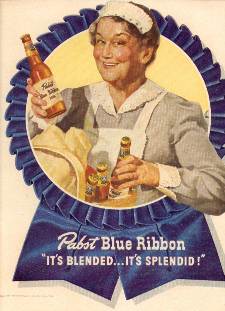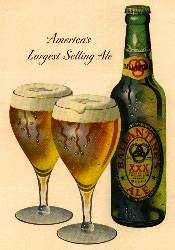|
Father's Day 2003
Your father's beer
 If you live in Chicago, you might order a Goose Island IPA while your dad asks for an Old Style. Or maybe he orders a Spaten Maibock while you sip a Bud Light.
If you live in Chicago, you might order a Goose Island IPA while your dad asks for an Old Style. Or maybe he orders a Spaten Maibock while you sip a Bud Light.
For dads and their children (or grandchildren), it's not as important what kind of beer they drink as it is that they enjoy the beer together.
However, the beers your father had with his father is likely different than the ones you and your father shared today. Theed variety of beers that have become available since most dads in the United States reached drinking age is staggering. Writing in his first "Pocket Guide to Beer" in 1982, Michael Jackson noted: "The fundamental criticism of U.S. beers is ... that they lack variety. The overwhelming majority of beers produced in the U.S. are of but one style: they are pale lager beers.... They do not all taste exactly the same, but the differences between them are often of minor consequence."
The range of beers available, both the styles brewed by American craft brewers and fresh imports, has exploded since the early 1980s. But while beer drinkers today have more choices, people 40 to 50 years ago were more likely to be drinking different beers from those being drunk two states away. Beer was much more of a regional product.
Consider these numbers:
In 1950, American breweries produced 83 million barrels of beer, 68 million of which were by breweries other than the top four.
In 2002, American breweries produced 180 million barrels for domestic consumption, with all but 8 million brewed by the three largest brewing companies.
In 1950, Joseph Schlitz Brewing was the nation's top producer with 6% of the market. In 2002, Anheuser-Busch was the top producer with more than 50% market share. The top four -- A-B, Miller, Coors and Pabst -- made almost 90% of the beer.
In 1950, Schlitz brewed 5 million barrels of beer, and No. 10 Pfeiffer Brewing Co. brewed 1.6 million. In 2002, A-B produced almost 102 million and No. 10 City Brewery made 566,000 barrels.
When dad stopped in the tavern or brought home beer in the 1950s or 1960s there was a better chance it came from a local or regional brewery. At that time, residents of San Antonio, Texas, drank Lone Star beer from the Lone Star brewery in San Antonio (soon it will be made at a Miller Brewing plant in Fort Worth). Beer drinkers in Peoria Heights, Illinois, would order "green beer" from a Pabst Brewery literally right around the corner.
Many of these brands of the 1950s and 1960s live on even though the breweries are gone. They are now contract brewed in plants far from their original homes, often in breweries owned by Miller. We don't really know what Ballantine or Lucky Lager or even Schlitz tasted like decades ago, but we do know these beers suited dad just fine.
 None had a loyaler following than Ballantine, particularly the IPA and Burton. The latter was aged up to 10 years in wooden tanks and was given to brewery employees and special friends with a label that include the name of the recipient. None had a loyaler following than Ballantine, particularly the IPA and Burton. The latter was aged up to 10 years in wooden tanks and was given to brewery employees and special friends with a label that include the name of the recipient.
Not long ago, Fred Eckhardt wrote, "Ballantine IPA would be a good choice for the greatest and most enduring American brewing triumph of the early and mid-20th century." Pabst now owns the Ballantine brand and brews only Ballantine XXX at its Lehigh Valley, Pennsylvania, plant. It is the sixth brewery Ballantine has been brewed at since its glory days in Newark, New Jersey, and the beer is now much different and considerably more mainstream.
The original Ballantine IPA was 7.5% alcohol by volume and very hoppy (60 IBUs). The brewery distilled its own hop oils and added them to storage tanks made of oak. The beer was aged in wood for a full year.
Although the current Ballantine XXX is a modest 5.5% alcohol and just 22 IBUs, the IPA remained a distinctive beer even after leaving Newark (Falstaff bought the brand and closed the brewery in 1972). Writing about it in 1982, Jackson noted: "Like a half-forgotten celebrity, thought by some admirers to have retired and by others to be dead, Ballantine has been living in quiet obscurity in Rhode Island."
Made then at the Narragansett brewery in Cranston, Rhode Island, it was still a hefty beer (7.5% alcohol, 45 IBUs) and aged four to five months in wooden tanks. Jackson gave it four stars (out of a possible five).
"It may be too intense for many people, but if you claim to be a beer drinker, you should at least try it," Jim Robertson wrote of the beer in 1982.
Production moved to the Midwest about that time, and the use of hop oils and wood aging became history. For many fathers, it ceased to be their beer.
|

